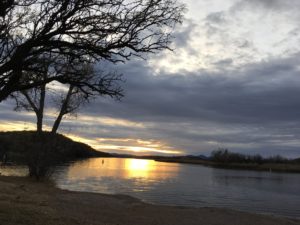
We pulled out of Phoenix on Friday and enjoyed the wide open desert drive south to Patagonia Lake State Park. Finally, we were back on the road. The campground was full, but quiet, and there were birds and trails, and we even went on an avian boating tour. And at the east end of the campground there was a bench overlooking the lake, with a half dozen seed and hummingbird feeders hanging from trees, and suet cakes and loose seed spread on a tray. Marika was in heaven.
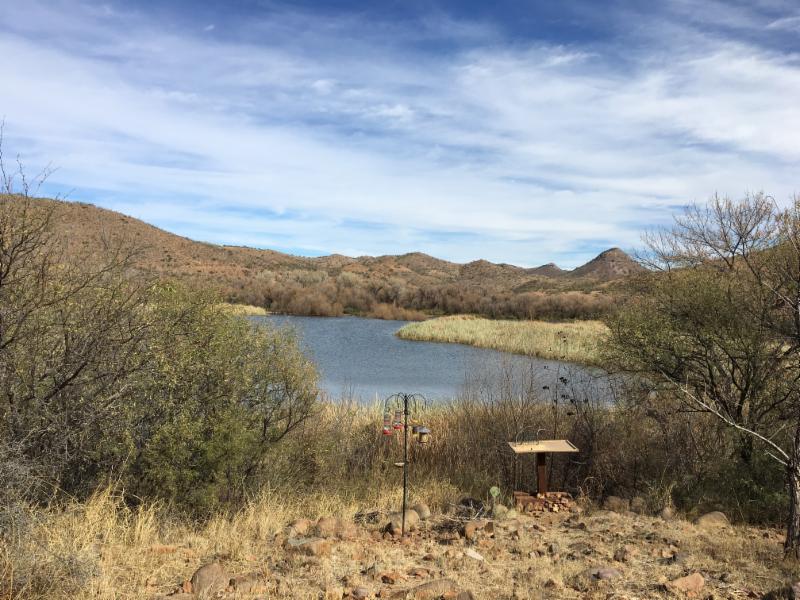
We stayed for three nights, sleeping late, reading, and relaxing. On Monday, the morning of our traveling day, instead of rushing to get on the road, Marika went birding at a nearby riparian area, and Cody and I took a walk to the birding bench. I talked with a camper about re-learning the joys of reading, and how she’ll be retiring in three years, and she wrote down the name of my book to download on her Kindle.
Instead of our usual nine o’clock departure, we didn’t pull out until almost noon. And it was an easy new choice to make, since we were only driving an hour to our next stop, the Holy Trinity Monastery in St David, a small town in southeastern Arizona, about an hour east of Tucson and about 50 miles north of the Mexico border. The monastery is situated on the San Pedro River, and is a popular stop for birders.

From 1974 until early 2017 Holy Trinity was an active Benedictine monastery with a retreat program. The monastery has recently undergone some major changes, with most of the monks now relocated elsewhere. But the place is still maintained by the Benedictine Olivetan Congregation and many volunteers. Some are local, others are wintering RVers of all religions who have been coming to the monastery for as many as twenty two years. They offer retreats and also have a small RV Park.
We pulled into the gates and spoke with Ann, a seventy nine year old retired nurse who lives in town and volunteers a few days a week in the gift shop. She said we needed to talk to Jan, who should be back soon. So we browsed the books and statues of saints, and learned that Ann had been a single mother with four kids, and her second husband had one child, and they lived in Iowa at the time, and he proposed to her in one sentence: “How would you like to marry me and move out to Arizona and open an RV Park?” And how could she say no to that.
We didn’t get to hear the rest of the story because Jan, the woman we’d been waiting for, finally arrived. But she wasn’t the person we needed to talk to. She told us to drive to the RV Park area and find Thelma, the RV park host. If she wasn’t in the Community Room cleaning pecans, she’d be in her trailer.
So we unhitched the car and drove the dirt road through the monastery grounds, past several modular buildings to the RV area, which consisted of three rows of campsites in the dirt, with several fifth wheels and trailers, and several empty spaces.
I walked down to the trailer marked RV HOST, and Thelma, a gray haired woman in her seventies, told me to pull in wherever, and fill out the registration information and she’d come and find us and collect the money, twenty dollars a night with full hookups.
We pulled into a middle row spot and, while I unpacked things inside, Marika talked with the woman in the golf cart across from us. She was a retired nun who had a post-stroke droop on the left side of her face. She worked at the monastery’s library, and we were welcome to come by. She explained that there was also a laundry and bathrooms, and she pointed to the fence where the bird trail was. And she said there is a meal at on o’clock every day if we were interested.
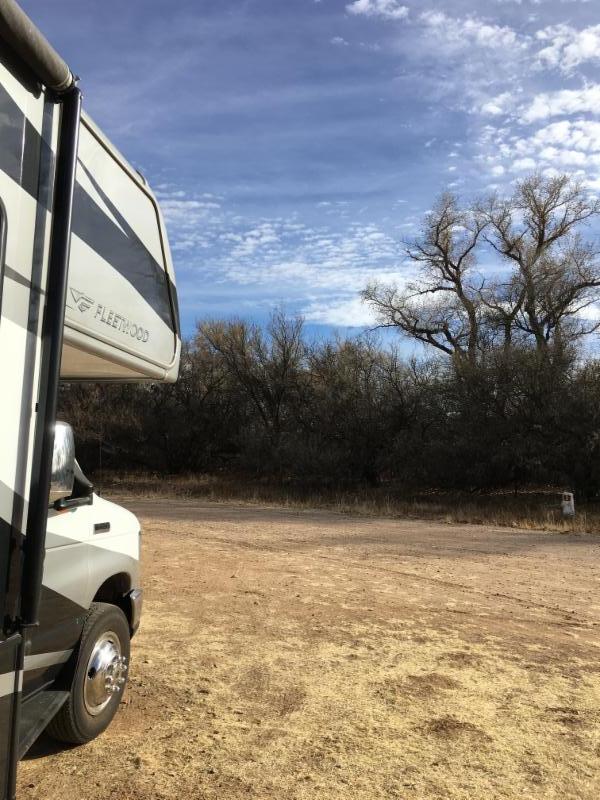
We had planned to just use the place as a hub for two days, and spend the following day in Bisbee, a place I’ve never been, and go on the tour of the mine. But after a gorgeous sunset walk along the bird trail, Marika and I both realized that we’d rather stay at the monastery, join the group for lunch, and do some volunteering and connecting with the people here. And so ,the next morning when Marika and Cody saw Thelma, she put us on the list for lunch and invited us to clean pecans at ten.
It was just the two of us, sitting at a round table in the Community Room, a forty by twenty foot room furnished with donated sofas and artwork and a piano that, according to Thelma, was beyond a good tuning.
Thelma poured five pounds of unshelled pecans on the table and explained that this was the end of last year’s crop. There were pecan pieces of all sizes mixed in with some good halves still clinging to their shell. She said we just needed to separate the shells from the edible pieces of pecans so they could use the nuts in the bakery. And not to worry about getting the bits of meat out of the shells – she’d feed them to the peacocks and javalinas.
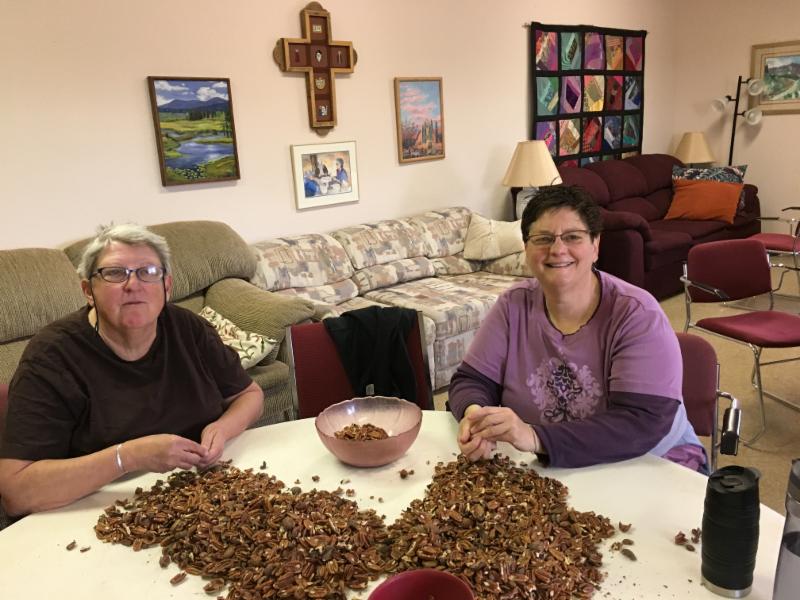
Marika and I each had a bowl to fill and, after an hour, my bowl was full and I was ready to stretch my body, refill my water bottle, go home to the bathroom and walk with Cody. Marika chose to stay and keep shelling.
Cody and I walked around the edge of the RV section, and along the back of the work shed. The grounds are surrounded with some of the oldest cottonwoods in the country, thick and tall, with silver dollar leaves that sound like they are whispering in a breeze.
It was so nice to be moving my body under the overcast sky that, even after Cody had pooped and peed and played, we kept going. We walked past the Community Center and I thought about stopping to tell Marika I wasn’t coming back, but then I realized that she’d figure it out. And that she’d be fine with it. That’s the beauty of our relationship. A lot of the time she does her thing, and I do mine, and it’s all good.
Cody and I followed the dirt road through the courtyard to the dining hall, near where the pastor lived, where his dog was barking barking barking as we walked by.
We found the 70-foot tall Celtic cross, a gift from some locals who wanted to put it on their own property, but their neighbors complained. And we discovered the meditation garden, for adults only. The sign didn’t say No Dogs, so we went through the metal gate and followed the path around the koi pond, over the narrow wooden bridges, Cody first, so I could make sure he didn’t get distracted by the water. He sniffed the dried grasses under the trees where the resident peacocks and hens wander, and I took pictures of the statues, the Japanese lanterns, the metalwork on the bridge.
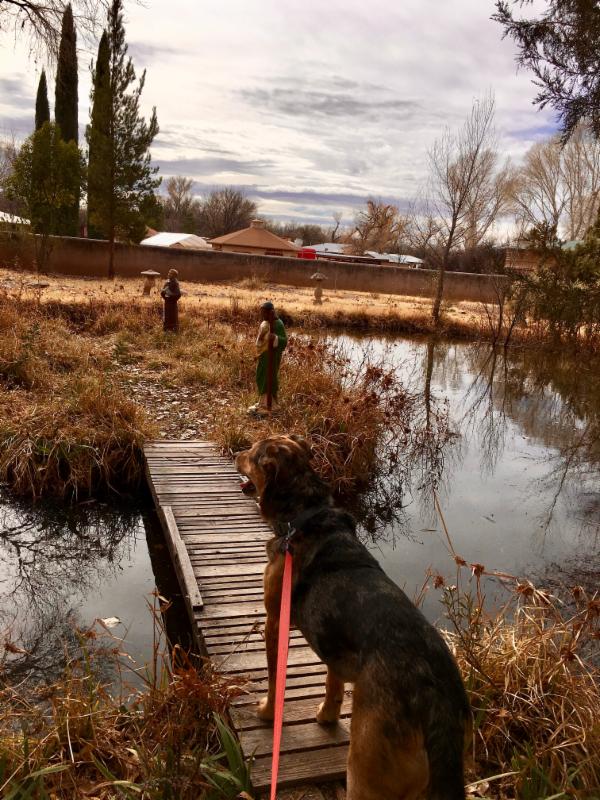
We left through the opposite gate and continued along the dirt roads, from St. Mary’s Way to St. Bernard Place, passing all different shaped buildings in various stages of newness. There were round wooden huts, barely big enough for a bed and a chair, and modest residence buildings with three or four units, each with a garden patio. I peeked into the windows of the large modern building and saw wooden floors and folding chairs, the space big enough to seat at least 200 people.
We stopped at the Benedict Peacock Thrift Store, but it is closed until January 31, when more volunteers are here. We went into the Quonset hut shaped Used Books building, with a sign that said Always Open, and we were greeted by the sweet smell of old musty books. I kept the door open and looked around at the shelves along the angled walls, each section identified with handwritten signs: Theology, Psychology, Scripture, Spiritual Life. The fiction books were unsorted in boxes underneath the only table in the room.
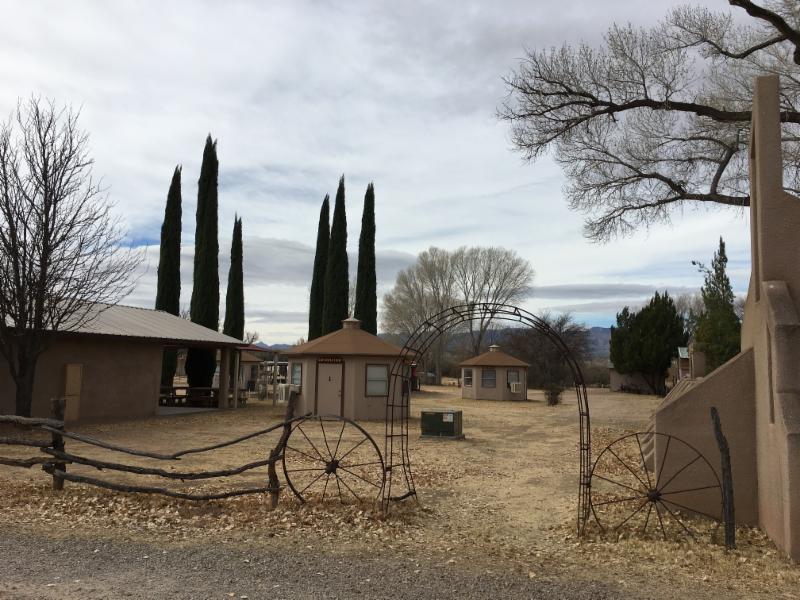
We followed the dirt road to the building with a Museum sign and rusty farm equipment on either side of the doorway. The door was locked and I could only see blackness through the windows. The Monastery Library was next door, and one of the double doors was unlocked, but the lights weren’t on, so we didn’t go in.
We turned onto St. Anselm’s Place and stopped at an area called La Fonda, with picnic tables under a wooden ramada, and a bright red utility trailer outfitted as a food truck. Another round building with an order window facing the picnic area had a taped sign on the window advertising bottled water and soda for sale. But everything was closed. I’m guessing it’s all open for their annual Art Fair the first week in November.
And as we walked, Cody sniffed the dried grass and piles of leaves where the resident peacocks and peahens had gathered. They watched us from behind the cottonwood trees, pecking the air, their big chicken-like feet kicking up the dust as they walked toward us, then away.
By the time we got home, Marika was there and we walked up to Benedict Hall to have lunch with some of the volunteers. After a simple blessing, we enjoyed a chicken and mushroom casserole, a full salad bar, and wonderful conversations.
Mary Ann, a dark haired woman in her fifties, has been at the monastery for two years. She came for a ten-day retreat, then applied for the three-month Oblates apprenticeship. She loved it, applied for full time status and was voted in. She sold everything, and feels that being here is a true blessing.
One of the men, Joe, used to lead RV tours and was an avid birder. We asked him about birding in Big Bend, and Thelma told us how she was camping in a trailer there with her nine kids, and there were no markets for miles and she only had one pound of ground beef to feed everybody. So she added some beans and onions, and made chili, and fed ten people with one pound of meat.
We talked about the pecans, and Annie, a retired nurse from Colorado, and her husband Charlie, invited us to work on the belt after lunch. So, after a walk with Cody, we met them at the Nut Hustler machine, where the pecan processing really begins.
There are more than a hundred pecan trees on the monastery property. To harvest the nuts, the monks lay tarps on the ground, then wrap a band around the tree and a machine vibrates the tree at the trunk. The pecans drop to the ground, onto the tarps.
The tarps are brought to the Nut Hustler machine and one person shovels the pecans into the machine. The machine immediately separates branches, leaves and broken pods and spits them in a pile on the side of the machine. The remainder drops down a chute onto a moving screened conveyor belt where four people, two on each side, pick out the perfect pecans, out of their pods but still in their shells.
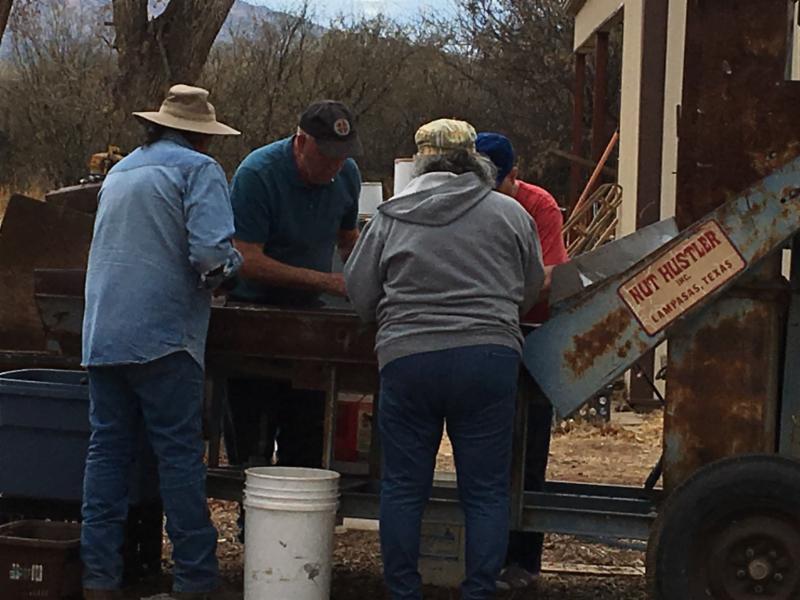
Marika and I stood on opposite sides of the conveyor belt next to Annie and a quiet woman named Rachel. Annie turned the motor on and a load of brown stuff dumped onto the belt. There were remnants of pecan pods, some sticks, several pods that hadn’t opened, a few pecans with cracked shells, and many beautiful pecans, pristine in their shell. Our job was to pick out the perfect pecans and put them in a white bucket, and toss any sticks and unopened pods over our shoulder. Juan, Rachel’s husband, stood at the end of the belt, facing the machine, the last person to pick out any good pecans that had slipped by us, before dropping into the compost chute.

Marika and I grabbed for the perfect pecans, picking them up, first, one at a time, then by the handful, as the machine seemed to get faster. Yes, there were jokes about Lucy and Ethel and the chocolate factory, and it was easy to miss a few pecans. When there were too many nuts on the belt to sort through, Annie would stop the conveyor belt and we’d pick out the good ones, toss the trash over our shoulders, and then Juan would sweep the rest to the compost chute.
After a few minutes of working at the fast moving belt, the sideways motion of the screen and the belt below it made me dizzy. So Juan and I switched places and I was now in charge of quality control.
Above us the sky shifted from silver gray to steel, and a breeze kicked up the discarded pods that the machine had spit out. And then it started to drizzle. Annie stopped the machine and we quickly picked through what was on the conveyor belt. Charlie, who had been shoveling the nuts into the machine, wrapped a tarp over the nuts and the machinery to keep everything dry.
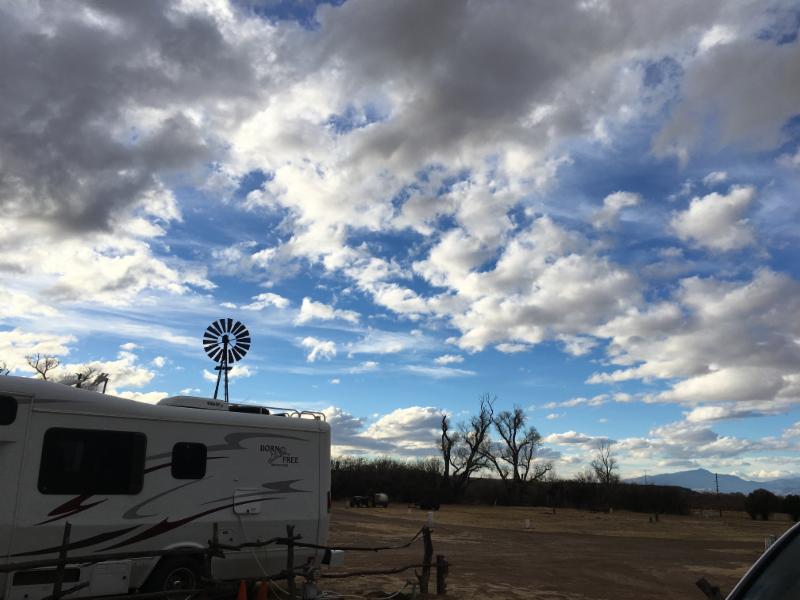
Annie took us into a small building and showed us the nut cracking machines. She explained that they’d dump each of our buckets of pecans into the cracker. They’d go through a second machine to shake the pecan meat from the cracked shells, then they’d soak the shelled nuts overnight to further loosen the nut meat from the shells. The nuts would be dried on a screen in the sun, then taken up to the community room to be shelled. It was cool that we had been a part of the first and last steps of the pecan process.
We walked home in a light drizzle and watched some TV and then, even though a previous me would have been peopled out by now, I said yes to meeting with Thelma and Annie for happy hour at five. Marika brought a beer, I had my bottle of water, and we sat outside, wrapped in jackets, sharing stories, and feeding pretzels to the peacocks and hens.

We watched the peacocks hop into highest branches of the giant cottonwood tree near the chapel to roost for the night. The distant storm skies darkened and the sun went down, and it was quickly too cold to stay outside. We said goodnight and there were hugs all around.
In the morning, I gave Thelma a copy of my book to share with everyone, and we stopped at the gift shop to buy a loaf of the famous monastery bread and, of course, a three-pound bag of pecans for the road.
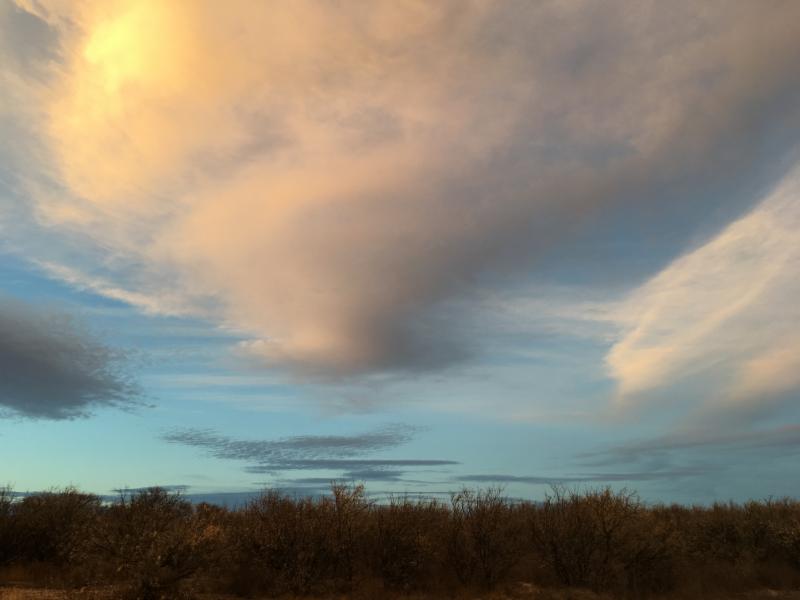
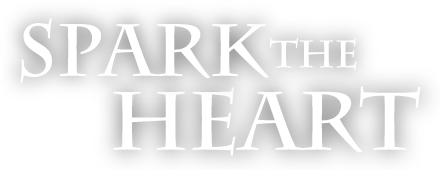
wow! I want to go there!